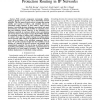Free Online Productivity Tools
i2Speak
i2Symbol
i2OCR
iTex2Img
iWeb2Print
iWeb2Shot
i2Type
iPdf2Split
iPdf2Merge
i2Bopomofo
i2Arabic
i2Style
i2Image
i2PDF
iLatex2Rtf
Sci2ools
123
Voted
INFOCOM
2010
IEEE
2010
IEEE
On the Feasibility and Efficacy of Protection Routing in IP Networks
With network components increasingly reliable, routing is playing an ever greater role in determining network reliability. This has spurred much activity in improving routing stability and reaction to failures, and rekindled interest in centralized routing solutions, at least within a single routing domain. Centralizing decisions eliminates uncertainty and many inconsistencies, and offers added flexibility in computing routes that meet different criteria. However, it also introduces new challenges; especially in reacting to failures where centralization can increase latency. This paper leverages the flexibility afforded by centralized routing to address these challenges. Specifically, we explore when and how standby backup forwarding options can be activated, while waiting for an update from the centralized server after the failure of an individual component (link or node). We provide analytical insight into the feasibility of such backups as a function of network structure, and quanti...
Related Content
| Added | 05 Mar 2011 |
| Updated | 05 Mar 2011 |
| Type | Journal |
| Year | 2010 |
| Where | INFOCOM |
| Authors | Kin Wah Kwong, Lixin Gao, Roch Guérin, Zhi-Li Zhang |
Comments (0)

